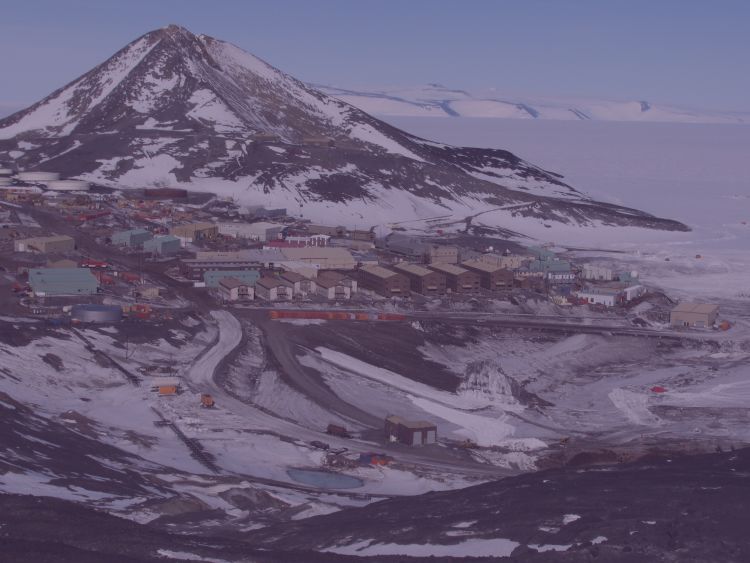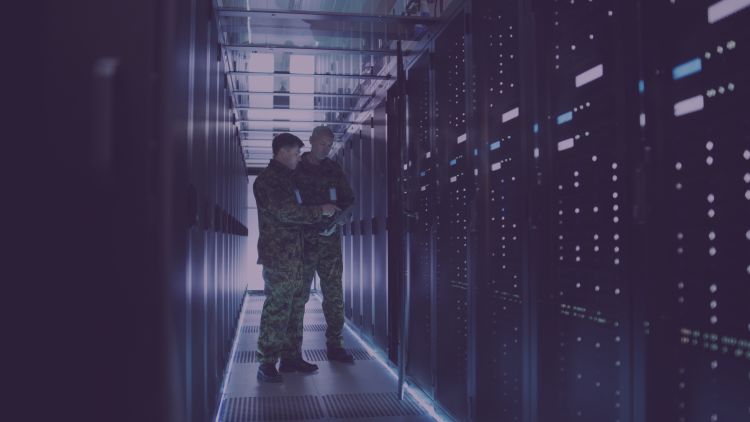Infrastructure Management
and Operation–
Freeing Agencies to Execute
Critical Missions

The federal government performs a wide range of critical missions in challenging environments around the world, from polar research to intelligence gathering in top secret facilities to environmental management of legacy nuclear development sites. Trained specialists carry out these tasks, and partnering with experienced professionals for complex infrastructure management and operation lets the specialists concentrate on their missions without distraction.
Leidos is a global technology solutions and services provider, experienced in solving the toughest challenges for the defense, intelligence, security, scientific research and public health communities. Its professionals provide vital mission support for government and commercial customers, managing logistics and operating and maintaining physical and IT infrastructures under all conditions, on small campuses and on federal reservations covering hundreds of square miles. As the scale and complexity of a mission increases, consolidating infrastructure management under a single experienced provider allows agencies to concentrate resources on core missions.
Regardless of the task—biomedical research or a decades-long environmental cleanup project—the common denominator is efficiency. Improving operational efficiency enables missions to be executed without interruption. Leidos has a proven track record of providing this efficiency for federal agencies under all conditions.
U.S. Department of Energy
Hanford Site Cleanup
The Department of Energy is conducting one of the largest nuclear cleanup efforts in the world, dealing with the legacy of supporting nuclear weapons production at the Hanford Site in southwest Washington. The site covers almost 600 square miles, larger than the city ofLos Angeles, and includes hundreds of buildings and nine decommissioned nuclear reactors.
Plutonium production began during World War II and continued into the 1980s. When production stopped, investment in the infrastructure—roads, communications, power service, water and sewage facilities—became secondary to environmental cleanup efforts, which began in 1989.
Today, more than 8,000 workers remain active on the Hanford Site and investment in the infrastructure is again necessary to support ongoing cleanup and remediation efforts
“Maintaining and upgrading the infrastructure and providing quality services is key for ongoing cleanup efforts. Without those fundamental services, progress in cleanup would not be possible,” said Bob Wilkinson, president of Mission Support Alliance (MSA).

Bob Wilkinson, President of the Mission Support Alliance (MSA), Leidos
With Leidos as the largest partner, MSA maintains and operates Hanford’s infrastructure. MSA manages not only the water, power, sewer, security and fire protection infrastructure of a large community, it also provides specialized services, including cranes and rigging, fleet maintenance, emergency response, environmental sustainability, long term stewardship and transportation. MSA has a highly qualified and skilled workforce that has provided critical support to multiple cleanup projects at Hanford across five prime contractors. Our employees consistently and safely complete complex tasks that make cleanup possible.
Much of the work is highly customized. Wilkinson points out, “Our employees are able to provide the right solution at the right and for the right value. Through our know-how, cutting edge technology, and intimate site knowledge we are able to keep workers safe, balance costs with value, and support vital mission execution.”
As the integrator at Hanford, MSA focuses on site-wide operational excellence. “When we see an opportunity for improvement, we partner with others to make it happen. Through economies of scale, providing on-demand services and implementing technological innovations,” Wilkinson states, “we are able to save the government - and the tax-payers - money.” Since the contract began in 2009, that amounts to cumulative cost savings and avoidance of close to $500 million.

National Science Foundation
Antarctic Support Contract (ASC)
The U.S. Antarctic Program, which is managed by the National Science Foundation, funds researchers nationwide and operates three research stations in the most remote parts of the globe. McMurdo Station, the largest research station on the continent of Antarctica, reaches a peak population of 1,000 during the austral summer (October-February). Amundsen-Scott South Pole Station, the most remote location on Earth, has 150 personnel during the summer. Palmer Station, the smallest of the three U.S. facilities, can accommodate up to 45 people. In addition, there are two research vessels and dozens of seasonal field camps located in the interior of the southernmost continent.
These stations are supplied by ship with 20 tons of cargo just once a year. “Everything needed to live, work and survive has to be planned over a 12- to 14-month schedule,” said Jerry McDonald, program director of the Leidos Antarctic Support Contract. Leidos handles all logistics for the U.S. Antarctic Program, including procurement of all food and supplies, supply chain management, operational support for science programs, operation of research vessels, onsite facilities engineering and construction, and transportation to and from the ice. It also performs medical screening for 3,000 people each year to ensure they are fit enough to handle the rigors of polar isolation and extreme conditions.

Jerry McDonald, Program Director of the Leidos Antarctic Support Contract
“Every dollar spent on logistics is one dollar less spent on science,” McDonald said. Streamlining logistics is essential to ensure that science can be done. By using Lean Six Sigma process improvement, Leidos has been able to reduce the contractor workforce by 20 percent. The company uses the IBM Maximo enterprise asset management solution, customized to support work orders, to improve efficiency, visibility and cost control. Communications and IT systems have been upgraded and a station modernization program at McMurdo is expected to reduce the contractor workforce by another 10 percent, opening up more room for researchers at the stations.
The result is that more dollars are being spent on science, and researchers have the resources they need to concentrate on their mission in the most extreme environment on Earth.
Every dollar spent on logistics is one dollar less spent on science.

Intelligence Community
Defense and Intelligence Support
Fort Gordon, Georgia, the home of the U.S. Army’s Cyber Center of Excellence, hosts a Sensitive Compartmented Information Facility (SCIF), an intelligence facility with restricted access requiring security clearances. Under a Defense and Intelligence Support Contract, Leidos maintains and manages operations for the 700,000 square-foot facility.
Our responsibility is to make sure the lights stay on,” said Ron Fodor, Leidos division manager for the contract. “It sounds pretty plain vanilla, but it’s not. It’s a broad scope of work for a sensitive customer and mission.”

Ron Fodor, Leidos Division Manager
That scope includes the building’s high and low voltage electric, plumbing and HVAC maintenance, technical task orders for new work, custodial services and lawn care, as well as IT support for automation of critical mechanical and electrical infrastructure – all 60 employees supporting this scope of work must have appropriate security clearances. Operational excellence and customer satisfaction have the highest priority, and contractors have earned a 4.8 out of five quality assurance rating. Original purchase, development and use of IBM Maximo for enterprise asset management has optimized ordering, tracking and pricing. It enables just-in-time ordering to reduce inventory storage, an important factor in a SCIF, where space is at a premium.
With efficient operations and maintenance support, SCIF teams are able to operate without interruption or distraction.
Our responsibility is to make sure the lights stay on. It sounds pretty plain vanilla, but it's not. It's a broad scope of work for a sensitive customer and mission.


Eric Stahlberg, PhD., Director of High-Performance Computing at the National Laboratory
National Institutes of Health
Frederick National Laboratory for Cancer Research
The Frederick National Laboratory (FNL), in Maryland, sponsored by the NIH’s National Cancer Institute, performs research on cancer, AIDS and infectious diseases. Its 2,000 employees monitor 400 ongoing human clinical trials in the U.S. and overseas.
Leidos Biomedical Research, Inc. operates the facility, leading research activity as well as providing high-performance computing; data transfer, storage and security; and the overall IT infrastructure. It currently manages more than five petabytes of data, a volume that is growing substantially each year.
“Our focus is on accelerating medical research as the effort becomes more data-focused and computational,” said Eric Stahlberg, Ph.D and director of high-performance computing at the national laboratory.
As research becomes increasingly dependent on computational simulation and analysis, research staff members at FNL, which Leidos Biomedical operates, engage with the wider biomedical research community to identify trends, anticipate problem and explore opportunities in leveraging the growing volume of data being generated. Data must be gathered, housed and annotated to enable expanding computational capabilities and improve research productivity.
In 2014, Leidos began working with the Department of Energy (DOE), which operates the world’s largest computational system for advanced scientific research, to explore emerging capabilities for exploiting large volumes of data. This led to a collaboration between FNL, the National Cancer Institute and DOE and its national laboratories to use the department’s high-performance computing capabilities to advance the use of predictive modeling in the lab’s research.
The goal of Leidos’ support is not simply to keep FNL operating smoothly and enable current research, but to identify future needs and align them with emerging capabilities. This maximizes the productivity of researchers and advances their missions cost-effectively. “It’s not just about enabling what is needed today, but focusing also on future aims, and then helping the customer realize that vision,” Stahlberg said.
“Our focus is on accelerating medical research as the effort becomes more data-focused and computational.”

By leveraging its experience in complex infrastructure management and operations, Leidos supports the federal government in carrying out its missions and in the delivery of critical national security, scientific and health services. The more critical and complex the mission, the more valuable the professional support that allows it to be executed under the most challenging conditions.
To learn more, visit leidos.com.

